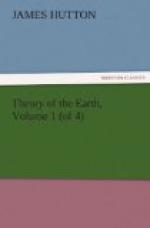Sand is the material which enters, perhaps in greatest quantity, the composition of our land. But sand, in general, is no other than small fragments of hard and solid bodies, worn or rounded more or less by attrition; consequently, the same natural history of the earth, which is investigated from the masses of gravel, is also applicable to those masses of sand which we find forming so large a portion of our present land throughout all the earth[16].
[Note 16: Sand is a term that denotes no particular substance; although by it is commonly meant a siliceous substance, as being by far the most prevalent. Sand is one of the modifications, of size and shape, in a hard body or solid substance, which may be infinitely diversified. The next modification to be distinguished in mineral bodies is that of gravel; and this differs in no respect from sand, except in point of size. Next after gravel, in the order of ascent, come stones; and these bear nearly the same relation to gravel as gravel does to sand. Now, by stones is to be understood the fragments of rocks or solid mineral bodies; and there is a perfect gradation from those stones to sand. I have already endeavoured to explain the formation of those stony substances; and now I am treating of a certain system of circulation, which is to be found among minerals.
M. de Luc censures me for not giving the origin of sand, of which I form the strata of the earth. He seems to have misunderstood my treatise. I do not pretend, as he does in his theory, to describe the beginning of things; I take things such as I find them at present, and from these I reason with regard to that which must have been. When, from a thing which is well known, we explain another which is less so, we then investigate nature; but when we imagine things without a pattern or example in nature, then, instead of natural history, we write only fable.
M. de Luc, in the letter already mentioned, says, “that sand may be, and I think it is, a substance which has formed strata by precipitation in a liquid.” This is but an opinion, which may be either true or false. If it be true, it is an operation of the mineral kingdom of which I am ignorant. In all the sand which I have ever examined, I have never seen any that might not be referred to the species of mineral substance from which it had been formed. When this author shall have given us any kind of information with regard to the production of sand by precipitation in a liquid, it will then be time enough to think of forming the strata of the earth with that sand.]
Clay is now to be considered as the last of those materials of which our strata are composed; but, in order to understand the nature of this ingredient, something must be premised.
Clay is a mixture of different earths or hard substances, in an impalpable state. Those substances are chiefly the siliceous and aluminous earths. Other earths are occasionally mixed in clays, or perhaps always to be found in some small portion. But this does not affect the general character of clay; it only forms a special variety in the subject. A sensible or considerable portion of calcareous earth, in the composition of clay, constitutes a marl, and a sufficient admixture of sand, a loam.




